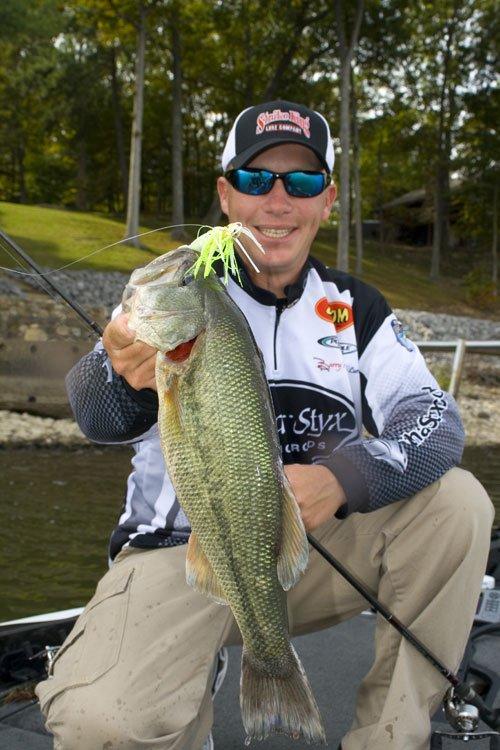Covering the “four corners of the earth” was always a funny phrase growing up, bass fishing notwithstanding. The fact that the earth is a sphere and thus has no corners, always made that phrase peculiar. Granted when the phrase was uttered the first time, man still thought the earth was flat like a map and thus it had four corners. But the phrase itself means to cover the entire thing from every end, corner or point on it.
In bass fishing, covering water or a piece of cover thoroughly is the name of the game, especially when the bass aren’t really aggressive and feeding. That four corner philosophy really separates casual anglers from very successful professional anglers.
Common pieces of cover found on most lakes and reservoirs from every corner of the country are manmade docks. There is a lot to be said about for fishing docks. And fishing a lake covered in docks can seem like a nightmare to a bass angler trying to break down a lake. The fact is the more method you can put to the madness of trying to narrow down which docks and which parts of which docks, the more success you’re going to have on a fishery and as a fisherman in general.
There are some names that come to mind when you mention different techniques. Biffle and Brauer pop into mind when you hear the phrase flipping and pitching. Kevin Van Dam and David Fritts come to mind when you mention crankbaits and fishing jigs around docks a few names come to mind there. But one name really wowed us a few years ago on the tournament trail fishing around docks.
Andy Montgomery of Grover, N.C. is a rising star on the Bassmaster Elite Series. He already has a B.A.S.S. Open win to his credit not to mention his recent 8th place finish in the FLW Forrest Wood Cup this past August. Montgomery belongs in the conversation with best ever around docks. Trust us. We’ve seen him work first hand in tournaments. But he humbly shies away from all the attention around his fishing.
“Guys get in the boat with me and immediately they want me to go fish docks and show them how I do it,” Montgomery said. “I don’t really know why. I like to catch them around docks, but I like to fish other ways too. The funniest time was when Rob Newell followed me at an FLW Tournament and he had another newspaper guy with him. I heard that guy utter an expletive after I slid a chatterbait up under a dock several casts in a row. Newell told him to sit down because he was ‘fixin’ to get schooled.’”
Montgomery just shrugs it off, but his prowess around docks comes from a surprising simple approach and a heck of a lot of time spent perfecting his casts and presentations around docks, having grown up around Lake Norman, which is literally covered in docks.
His approach often revolves around three sorts of jigs – a standard flipping jig, a swimming jig and a vibrating bladed jig. The latter is what we were most intrigued about, but knowing his system involves all three is interesting.
“Basically if the dock is in shallow water, I will fish a flipping jig on the bottom because the band of the water column is much narrower,” Montgomery said. “But as the water gets deeper on the docks, the fish might not come up or down as far and the fish have more of a tendency to suspend under the floats. That’s when I get a swim jig or a vibrating jig and fish around the floats more. The shallower docks get the bottom bouncing jig and the deeper docks get the more horizontal jigs.”
We talked targeting the docks with bottom bouncing jigs earlier this year with Gerald Swindle, so the focus of this discussion will stick with attacking docks while bass fishing with vibrating bladed jigs.
Montgomery, like his long-time friend and former fishing partner, Bryan Thrift, was fortunate to come up fishing around the area where the original Chatterbait was developed. So he’s been throwing the productive bass fishing longer than most people have known about it. He had the original owners pour him up a lifetime supply of heads and blades and he puts his own together now with skirts of his choice and his own keeper that locks trailers onto the lure so that he can do what he loves best with it.
“I get asked all the time why a Chatterbait and not a spinnerbait around docks,” Montgomery said. “It’s simple. I use a vibrating jig because it skips. Skipping is sometimes the only way to get the lure where I want to fish it. So I get a thumping active lure in a place where a lot of bass haven’t seen it.”
Montgomery’s skipping prowess is far beyond that of the average casting ability of most anglers. But with practice, everyone can get to the level of master skipper like Montgomery. But the learned skill is necessary to cover all the angles efficiently on a dock. Montgomery considers it imperative that you cover all four corners of a floating dock.
“The bass will often suspend right under the floats on the corners. So if you can bring a bait real close to each corner, you can find where they are positioned on each dock. If there is current present, it can position the fish in the same places on every dock in a stretch. So you want to make multiple casts to each corner to help establish the position of the fish relative to the docks and the surroundings.”
There are generally four corners to every dock. The back left, front left, front right and back right. Obviously they will have more slips in some than others and that can give you additional corners to target. The key is to bring the vibrating jig across the corners from various angles. The skipping comes into play when you want to get back behind the float, under a support beam and work the bait just under the corner.
Montgomery demonstrated this in a recent outing. He ran a series of docks. They were pulling current that day, and the stretch of docks were mostly single slip docks with 4 corners or just mooring docks with no slips. As he approached the dock from the left he hit the back corner. Then the front corner. Then he repositioned in front and hit the left front corner again. Then the right corner, then he positioned on the downstream right side of the dock and skipped up under a support beam. Just as the Chatterbait reached the dock, a 3-pound bass jumped out from under the dock and grabbed the bait.
He hit several more docks and caught a few more fish. In one stretch in 20 minutes, he had patterned the fish on docks suspending on the back, down current floats. Dialing in a pattern that specific can allow you to run a lot more water a lot faster.
Montgomery advises using a rod that matches your height for making the low roll cast you need to slide the bait into tight places. He’s a tall angler at 6-foot, 4-inches, so he can get away with a 7-foot, 2-inch Fetha Styx rod. But we’ve found that a 6-foot, 6-inch to 6-foot, 10-inch rod makes shooting a bait at a low angle with some velocity a lot easier if you’re legs aren’t quite as long. He also cautions anglers to focus on a rod that is 80 percent backbone and 20 percent tip. That way you can really load and sling shot a bait with a small wrist action.
Montgomery fishes it on 20-pound line opting for either monofilament or fluorocarbon. He’s thrown a lot of vibrating jigs. He still likes the Original Chatterbait heads he got from Rad Lures. It’s now made by Z-Man. One thing he likes about that head and the design is that when it contacts grass or some sort of cover, he can “bully whip” hard to free it and then start cranking again. Because the head and blade are not too separated, the Chatterbait will immediately start running true again. That often triggers fish to bite.
If the vibrating jig is made differently and the blade has too much play, he often finds when he snaps the rod hard, the blade will rotate and catch and cause the jig to sort of just snag through the water without vibrating anymore. As a result you miss the key moment in the retrieve when the fish is often trigger and ready to pounce but the bait no longer looks and swims like something alive.
He also has learned to tie Hitchhikers onto the shanks of the hooks with thread. He locks this onto his hook to hold his keeper tightly in place. Most keepers on vibrating jigs won’t hold the plastic in place after repeated skipping of the bait. The hitchhiker can really make the difference. The plastic actually aids with skipping the bait with it threaded all the way up the shank.
It’s always good to share a boat with someone who has mastered a certain technique or approach to bass fishing. And after seeing Montgomery work a stretch of docks, we had an uncontrollable itch to fish docks ourselves. How about you? How effective has your fall dock fishing been this season?












